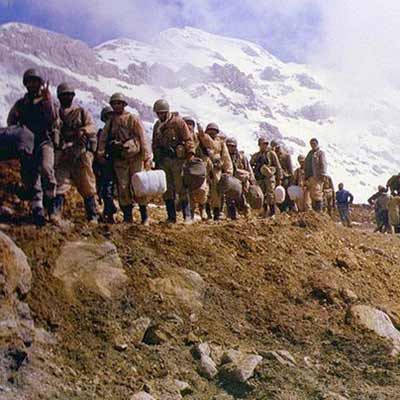Battles
Operation Nasr 8
Zeinab Ahmadi
198 Views
Operation Nasr 8 was carried out under the command of the Islamic Revolutionary Guard Corps (IRGC) to capture the Gerdeh Rash Heights in Sulaymaniyah Province, Iraq.
The area east of the Qaleh Chulan River in the northern part of Sulaymaniyah Province, up to Surkuh, had been captured in previous operations—Karbala 10 and Nasr 4—. Extending the operation westward required crossing the Qaleh Chulan River, which in turn depended on seizing the Gerdeh Rash Heights. Operation Nasr 8 was thus carried out by the IRGC to achieve this objective.[1]
Before Nasr 8, Operation Nasr 7 had been launched on August 5, 1987, to push Iraqi forces out of the Sardasht and liberate Dupaza and Buleft mountains, located 13 kilometers west of Sardasht.[2]
Commanded by Nour-Ali Shoushtari, the operation was conducted under the supervision of the Najaf Headquarters with the engagement of the 57th Abalfazl (as) Division, the 21st Imam Reza (as) Division, the 11th Amir al-Muminin (as) Division, and the 12th Qaem (as) Brigade. It began at 1:16 AM on November 20, 1987, with the code-name “Ya Muhammad ibn Abdullah (as) Adrekni” in Sardasht. Acting on the orders of the Najaf Headquarters, the units launched a coordinated and simultaneous attack on enemy positions and succeeded in fulfilling the objectives within an hour.[3]
Peaks 1426 (known as Peak One), 1418 (Peak Two), and 1391 (Peak Three), along with the tactical command post of Iraq’s 39th Brigade and the headquarters of its 1st Battalion, fell into Iranian hands. Only the headquarters of the 2nd Battalion, located further along the northern ridge of Gerdeh Rash, remained under Iraqi control. The first Iraqi counterattack began at 5:00 AM on the first day of the operation, led by the remnants of the 2nd Battalion of the 39th Brigade. As a result, the 57th Abalfazl (as) Division had to retreat roughly three kilometers along the Gerdeh Rash ridge. Therefore, the 57th Division was ordered to hold its ground until a battalion of the Special 155th Shuhada Division arrived and secured the remainder of the ridge. Meanwhile, the artillery units were commanded to deliver heavy fire on the Gerdeh Rash Heights.
Supplying the forces via land routes was extremely difficult due to the long distance and steep slope of Gerdeh Rash, and thus the Islamic Republic of Iran Army Aviation Corps (Havanirooz) was tasked with providing logistics and support.
The second phase of the operation was carried out on November 21, 1987. To mislead the enemy, the Quds Headquarters launched a diversionary attack east of the Qaleh Chulan River. Meanwhile, the Najaf Headquarters, taking advantage of the night blindness, attacked the right flank of the Gerdeh Rash Heights causing Iranian units to overrun the Iraqi positions.[4]
In the early morning of the second day, the Iraqi army counterattacked the positions held by the 21st Imam Reza (as) Division on Peak One of the Gerdeh Rash Heights. The attack began with intense artillery fire, followed by an infantry advance from Harmadan Hill and Gerdeh Rash. In response, Iranian forces, supported by artillery fire, launched a strong counterattack. On orders from the Najaf Headquarters, they carried out concentrated and heavy artillery fire on enemy positions, resulting in large numbers of Iraqi casualties along the Galaleh Road. About an hour later, the Iraqi units were forced to retreat. To secure the Iranian defense line, the Najaf Headquarters requested that the 52nd Quds Division and the 7th Vali Asr (as) Division be deployed to the area.[5]
On the third day of the operation (November 22nd), the Iraqi forces launched another attack at 2:00 AM but were repelled by the Iranians, resulting in the capture of several Iraqi soldiers. The Iraqis yet carried out another counteroffensive and managed to break through the connecting lines between the 7th Vali Asr (as) Division and the 57th Abalfazl (as) Division at Peak Two, as well as the positions held by the 7th Vali Asr (as) Division. However, the attack was met with strong resistance by Iranian troops who pushed the enemy back. That afternoon, Iraq again attacked Peak Two, but the assault failed to achieve any results.[6]
On the fourth day of the operation, at 5:15 PM, the Iraqi army attacked peaks 1 and 2 in an attempt to recapture the positions taken by Iranian forces. However, the Iranian counterattack repelled the offensive, and by around 6:00 PM, the Iraqi assault was halted.[7]
On the fifth day of the operation, the Iraqi attacks on the Gerdeh Rash Heights came to a stop mainly because yesterday the Patriotic Union of Kurdistan (PUK) had captured part of the Violan Heights. Consequently, the Iraqi troops were busy dealing with the situation in Violan, thereby shifting their focus away from the Gerdeh Rash front. As a result, on this day Iraq concentrated its efforts on retaking Violan, carrying out four aerial bombardments of PUK positions. Finally, under the pressure of Iraqi attacks, PUK forces gradually withdrew from Violan.[8]
Ultimately, the Iranian forces succeeded in capturing peaks 1426, 1428, and 1391 of the Gerdeh Rash Heights, as well as several Iraqi border outposts located on them. Moreover, some villages including Gamalan Zour, Gamalan Khward, Barger Bala, and Barger Paeen, and more than 30 kilometers of the northern area of Sulaymaniyah Province in Iraq were thus liberated. During this operation, the 39th Brigade of Iraq’s 44th Division and a tank battalion of the 27th Division were destroyed. Also, the 603rd, 83rd, and 77th infantry brigades and the commando battalion of the 44th Division lost much of their combat power. In addition, Iranian forces took control of the tactical headquarters of Iraq’s 39th Brigade and the IRGC units attacked the 2nd Battalion command post of the 504th Brigade, stationed at the Gahow Heights, with heavy artillery fire. Furthermore, two ammunition depots of the 139th Division in the Surqalat region and the headquarters of the 603rd, 83rd, and 300th brigades, along with the tactical headquarters of the 91st Brigade located at the Hezar Kamiyan Heights, were significantly damaged due to intense artillery shelling by Iranian forces.[9]
About 3000 Iraqi soldiers were killed or wounded during the operation, and 200 were taken prisoners. 6 tanks and several other pieces of equipment were destroyed, while 2 tanks, 6 radar units, various vehicles, 1 communication device, and more than 50 mortars were seized by Iranian forces. On the Iranian side, 173 personnel were martyred and 877 were wounded in the operation.[10]
On November 22, 1987, while Operation Nasr 8 was underway, the 64th Urmia Division of the Islamic Republic of Iran Army carried out Operation Nasr 9 in the Haj Omran region.[11]
[1] Rashid, Mohsen, Atlas-e Jang-e Iran va Araq (Atlas of the Iran-Iraq War), Tehran: Markaz-e Asnad va Tahqiqat-e Defa-e Muqaddas, 2nd ed., 2010, p. 96.
[2] Dorudian, Muhammad, Seyri dar Jang-e Iran va Araq, vol. 4: Shalamcheh ta Halabcheh (A Survey of the Iran-Iraq War, Vol. 4: From Shalamcheh to Halabcheh), Tehran: Markaz-e Asnad va Tahqiqat-e Defa-e Muqaddas, 1997, Pp. 194, 196.
[3] Ibid., p. 199; Ardestani, Hussain, Ruzshomar-e Jang-e Iran va Araq, Ketab-e Panjaah-o-dovvom: Takapou-ye Jahani baraye Tavaqqof-e Jang (Chronology of the Iran-Iraq War, Vol. 52: Global Efforts to Stop the War), Tehran: Markaz-e Asnad va Tahqiqat-e Defa-e Muqaddas, 2003, p. 32.
[4] Ardestani, Hussain, Ruzshomar-e Jang-e Iran va Araq, Ketab-e Panjaah-o-dovvom (Chronology of the Iran-Iraq War, Vol. 52), Pp. 50, 132–133.
[5] Ibid., Pp. 59–60.
[6] Ibid., p. 79.
[7] Ibid., p. 92.
[8] Ibid., Pp. 107, 119.
[9] Samiei, Ali, Karnama-ye Tawsifi-ye Amaliat-e Razmandegan-e Islam dar Toul-e Hasht Sal Defa-e Muqaddas (Descriptive Record of Islamic Combatants’ Operations during the Eight Years of Sacred Defense), Tehran: Moavenat-e Tablighat va Entesharat-e Namayandegi-ye Vali-ye Faqih dar Niro-ye Zamini, 1997, p. 363; Ruznameh-ye Jomhouri-ye Eslami (Jonhouri Eslami Newspaper), No. 2460, 22 November 1987, p. 2.
[10] Ardestani, Hussain, Ruzshomar-e Jang-e Iran va Araq, Ketab-e Panjaah-o-dovvom (Chronology of the Iran-Iraq War, Vol. 52), p. 120.
[11] Ibid., p. 80.





